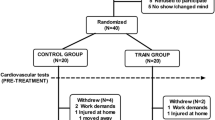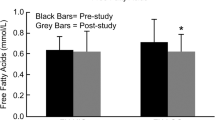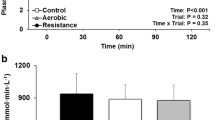Abstract
The aim of the study is to determine the effects of short-term high-intensity exercise on arterial function and glucose tolerance in obese individuals with and without the metabolic syndrome (MetSyn). Obese men and women (BMI > 30 kg/m2; 39–60 years) with and without MetSyn (MetSyn, n = 13; Non-MetSyn, n = 13) participated in exercise training consisting of ten consecutive days of treadmill walking for 1 h/day at 70–75% of peak aerobic capacity. Changes in aerobic capacity, flow-mediated dilation (FMD), and arterial stiffness using central and peripheral pulse wave velocity (PWV) measurements were assessed pre- and post-training. These measurements were obtained fasting and 1-h post-test meal while the subjects were hyperglycemic. Aerobic capacity improved for both groups [Non-MetSyn 24.0 ± 1.6 vs. 25.1 ± 1.5 mL/(kg min); MetSyn 25.2 ± 1.8 vs. 26.2 ± 1.7 mL/(kg min), P < 0.05]. There was no change in body weight. FMD decreased by ~20% (P < 0.05) for both groups during acute hyperglycemia (MetSyn, n = 11; Non-MetSyn, n = 10), while hyperglycemia increased central PWV and not peripheral PWV. Exercise training did not change FMD in the fasted or challenged state. Central and peripheral PWV were not altered with training for either group (MetSyn, n = 13; Non-MetSyn, n = 13). A 10-day high-intensity exercise program in obese individuals improved aerobic capacity and glucose tolerance but no change in arterial function was observed. Acute hyperglycemia had a deleterious effect on arterial function, suggesting that persons with impaired glucose homeostasis may experience more opportunities for attenuated arterial function on a daily basis which could contribute to increased cardiovascular risk.



Similar content being viewed by others
References
Akbari CM, Saouaf R, Barnhill DF, Newman PA, LoGerfo FW, Veves A (1998) Endothelium-dependent vasodilatation is impaired in both microcirculation and macrocirculation during acute hyperglycemia. J Vasc Surg 28:687–694. doi:10.1016/S0741-5214(98)70095-3
Alberti KG, Zimmet P, Shaw J (2006) Metabolic syndrome—a new world-wide definition. A consensus statement from the International Diabetes Federation. Diabet Med 23:469–480. doi:10.1111/j.1464-5491.2006.01858.x
Asmar R, Benetos A, Topouchian J, Laurent P, Pannier B, Brisac AM, Target R, Levy BI (1995) Assessment of arterial distensibility by automatic pulse wave velocity measurement. Validation and clinical application studies. Hypertension 26:485–490
Baynard T, Franklin RM, Goulopoulou S, Carhart R Jr, Kanaley JA (2005) Effect of a single vs multiple bouts of exercise on glucose control in women with type 2 diabetes. Metabolism 54:989–994. doi:10.1016/j.metabol.2005.02.015
Beckman JA, Creager MA, Libby P (2002) Diabetes and atherosclerosis: epidemiology, pathophysiology, and management. JAMA 287:2570–2581. doi:10.1001/jama.287.19.2570
Caballero AE, Arora S, Saouaf R, Lim SC, Smakowski P, Park JY, King GL, LoGerfo FW, Horton ES, Veves A (1999) Microvascular and macrovascular reactivity is reduced in subjects at risk for type 2 diabetes. Diabetes 48:1856–1862. doi:10.2337/diabetes.48.9.1856
Cameron JD, Dart AM (1994) Exercise training increases total systemic arterial compliance in humans. Am J Physiol 266:H693–H701
Ceriello A, Bortolotti N, Crescentini A, Motz E, Lizzio S, Russo A, Ezsol Z, Tonutti L, Taboga C (1998) Antioxidant defences are reduced during the oral glucose tolerance test in normal and non-insulin-dependent diabetic subjects. Eur J Clin Invest 28:329–333. doi:10.1046/j.1365-2362.1998.00295.x
Ceriello A, Taboga C, Tonutti L, Quagliaro L, Piconi L, Bais B, Da Ros R, Motz E (2002) Evidence for an independent and cumulative effect of postprandial hypertriglyceridemia and hyperglycemia on endothelial dysfunction and oxidative stress generation: effects of short- and long-term simvastatin treatment. Circulation 106:1211–1218. doi:10.1161/01.CIR.0000027569.76671.A8
Collier SR, Kanaley JA, Carhart R Jr, Frechette V, Tobin MM, Hall AK, Luckenbaugh AN, Fernhall B (2008) Effect of 4 weeks of aerobic or resistance exercise training on arterial stiffness, blood flow and blood pressure in pre- and stage-1 hypertensives. J Hum Hypertens 10:678–686. doi:10.1038/jhh.2008.36
Cononie CC, Goldberg AP, Rogus E, Hagberg JM (1994) Seven consecutive days of exercise lowers plasma insulin responses to an oral glucose challenge in sedentary elderly. J Am Geriatr Soc 42:394–398
Corretti MC, Anderson TJ, Benjamin EJ, Celermajer D, Charbonneau F, Creager MA, Deanfield J, Drexler H, Gerhard-Herman M, Herrington D, Vallance P, Vita J, Vogel R (2002) Guidelines for the ultrasound assessment of endothelial-dependent flow-mediated vasodilation of the brachial artery: a report of the International Brachial Artery Reactivity Task Force. J Am Coll Cardiol 39:257–265. doi:10.1016/S0735-1097(01)01746-6
Cosentino F, Hishikawa K, Katusic ZS, Luscher TF (1997) High glucose increases nitric oxide synthase expression and superoxide anion generation in human aortic endothelial cells. Circulation 96:25–28
Cosentino F, Eto M, De Paolis P, van der Loo B, Bachschmid M, Ullrich V, Kouroedov A, Delli Gatti C, Joch H, Volpe M, Luscher TF (2003) High glucose causes upregulation of cyclooxygenase-2 and alters prostanoid profile in human endothelial cells: role of protein kinase C and reactive oxygen species. Circulation 107:1017–1023. doi:10.1161/01.CIR.0000051367.92927.07
Cruickshank K, Riste L, Anderson SG, Wright JS, Dunn G, Gosling RG (2002) Aortic pulse-wave velocity and its relationship to mortality in diabetes and glucose intolerance: an integrated index of vascular function? Circulation 106:2085–2090. doi:10.1161/01.CIR.0000033824.02722.F7
Edwards DG, Schofield RS, Magyari PM, Nichols WW, Braith RW (2004) Effect of exercise training on central aortic pressure wave reflection in coronary artery disease. Am J Hypertens 17:540–543. doi:10.1016/j.amjhyper.2003.12.001
Emoto M, Nishizawa Y, Kawagishi T, Maekawa K, Hiura Y, Kanda H, Izumotani K, Shoji T, Ishimura E, Inaba M, Okuno Y, Morii H (1998) Stiffness indexes beta of the common carotid and femoral arteries are associated with insulin resistance in NIDDM. Diabetes Care 21:1178–1182. doi:10.2337/diacare.21.7.1178
Giannattasio C, Zoppo A, Gentile G, Failla M, Capra A, Maggi FM, Catapano A, Mancia G (2005) Acute effect of high-fat meal on endothelial function in moderately dyslipidemic subjects. Arterioscler Thromb Vasc Biol 25:406–410. doi:10.1161/01.ATV.0000152231.93590.17
Gokce N, Holbrook M, Hunter LM, Palmisano J, Vigalok E, Keaney JF Jr, Vita JA (2002) Acute effects of vasoactive drug treatment on brachial artery reactivity. J Am Coll Cardiol 40:761–765. doi:10.1016/S0735-1097(02)02034-X
Goodyear LJ, Kahn BB (1998) Exercise, glucose transport, and insulin sensitivity. Annu Rev Med 49:235–261. doi:10.1146/annurev.med.49.1.235
Goto C, Higashi Y, Kimura M, Noma K, Hara K, Nakagawa K, Kawamura M, Chayama K, Yoshizumi M, Nara I (2003) Effect of different intensities of exercise on endothelium-dependent vasodilation in humans: role of endothelium-dependent nitric oxide and oxidative stress. Circulation 108:530–535. doi:10.1161/01.CIR.0000080893.55729.28
Green DJ, Maiorana A, O’Driscoll G, Taylor R (2004) Effect of exercise training on endothelium-derived nitric oxide function in humans. J Physiol 561:1–25. doi:10.1113/jphysiol.2004.068197
Hamdy O, Ledbury S, Mullooly C, Jarema C, Porter S, Ovalle K, Moussa A, Caselli A, Caballero AE, Economides PA, Veves A, Horton ES (2003) Lifestyle modification improves endothelial function in obese subjects with the insulin resistance syndrome. Diabetes Care 26:2119–2125. doi:10.2337/diacare.26.7.2119
Henry RM, Kostense PJ, Spijkerman AM, Dekker JM, Nijpels G, Heine RJ, Kamp O, Westerhof N, Bouter LM, Stehouwer CD (2003) Arterial stiffness increases with deteriorating glucose tolerance status: the Hoorn Study. Circulation 107:2089–2095. doi:10.1161/01.CIR.0000065222.34933.FC
Huang CL, Chen MF, Jeng JS, Lin LY, Wang WL, Feng MH, Liau CS, Hwang BS, Lee YT, Su TC (2007) Postchallenge hyperglycaemic spike associate with arterial stiffness. Int J Clin Pract 61:397–402. doi:10.1111/j.1742-1241.2006.01227.x
Johnson LR, Rush JW, Turk JR, Price EM, Laughlin MH (2001) Short-term exercise training increases ACh-induced relaxation and eNOS protein in porcine pulmonary arteries. J Appl Physiol 90:1102–1110. doi:10.1063/1.1383260
Katz A, Nambi SS, Mather K, Baron AD, Follmann DA, Sullivan G, Quon MJ (2000) Quantitative insulin sensitivity check index: a simple, accurate method for assessing insulin sensitivity in humans. J Clin Endocrinol Metab 85:2402–2410. doi:10.1210/jc.85.7.2402
Kawano H, Motoyama T, Hirashima O, Hirai N, Miyao Y, Sakamoto T, Kugiyama K, Ogawa H, Yasue H (1999) Hyperglycemia rapidly suppresses flow-mediated endothelium-dependent vasodilation of brachial artery. J Am Coll Cardiol 34:146–154. doi:10.1016/S0735-1097(99)00168-0
Kimoto E, Shoji T, Shinohara K, Inaba M, Okuno Y, Miki T, Koyama H, Emoto M, Nishizawa Y (2003) Preferential stiffening of central over peripheral arteries in type 2 diabetes. Diabetes 52:448–452. doi:10.2337/diabetes.52.2.448
Kingwell BA (2000) Nitric oxide as a metabolic regulator during exercise: effects of training in health and disease. Clin Exp Pharmacol Physiol 27:239–250. doi:10.1046/j.1440-1681.2000.03232.x
Laughlin MH, Rubin LJ, Rush JW, Price EM, Schrage WG, Woodman CR (2003) Short-term training enhances endothelium-dependent dilation of coronary arteries, not arterioles. J Appl Physiol 94:234–244
Lemieux S, Prud’homme D, Bouchard C, Tremblay A, Despres JP (1996) A single threshold value of waist girth identifies normal-weight and overweight subjects with excess visceral adipose tissue. Am J Clin Nutr 64:685–693
Lundman P, Tornvall P, Nilsson L, Pernow J (2001) A triglyceride-rich fat emulsion and free fatty acids but not very low density lipoproteins impair endothelium-dependent vasorelaxation. Atherosclerosis 159:35–41. doi:10.1016/S0021-9150(01)00478-6
Major-Pedersen A, Ihlemann N, Hermann TS, Christiansen B, Dominguez H, Kveiborg B, Nielsen DB, Svendsen OL, Kober L, Torp-Pedersen C (2008) Effects of oral glucose load on endothelial function and on insulin and glucose fluctuations in healthy individuals. Exp Diabetes Res 2008:672021, 6 p
Mancini GB, Yeoh E, Abbott D, Chan S (2002) Validation of an automated method for assessing brachial artery endothelial dysfunction. Can J Cardiol 18:259–262
McAllister RM, Laughlin MH (1997) Short-term exercise training alters responses of porcine femoral and brachial arteries. J Appl Physiol 82:1438–1444. doi:10.1063/1.365921
Nestel PJ, Shige H, Pomeroy S, Cehun M, Chin-Dusting J (2001) Post-prandial remnant lipids impair arterial compliance. J Am Coll Cardiol 37:1929–1935. doi:10.1016/S0735-1097(01)01251-7
Ohshita K, Yamane K, Ishida K, Watanabe H, Okubo M, Kohno N (2004) Post-challenge hyperglycaemia is an independent risk factor for arterial stiffness in Japanese men. Diabet Med 21:636–639. doi:10.1111/j.1464-5491.2004.01161.x
Parnell MM, Holst DP, Kaye DM (2002) Exercise training increases arterial compliance in patients with congestive heart failure. Clin Sci (Lond) 102:1–7. doi:10.1042/CS20010107
Pierce GL, Beske SD, Lawson BR, Southall KL, Benay FJ, Donato AJ, Seals DR (2008) Weight loss alone improves conduit and resistance artery endothelial function in young and older overweight/obese adults. Hypertension 52:72–79. doi:10.1161/HYPERTENSIONAHA.108.111427
Rogers MA, Yamamoto C, King DS, Hagberg JM, Ehsani AA, Holloszy JO (1988) Improvement in glucose tolerance after 1 week of exercise in patients with mild NIDDM. Diabetes Care 11:613–618. doi:10.2337/diacare.11.8.613
Sessa WC, Pritchard K, Seyedi N, Wang J, Hintze TH (1994) Chronic exercise in dogs increases coronary vascular nitric oxide production and endothelial cell nitric oxide synthase gene expression. Circ Res 74:349–353
Siafarikas A, Watts K, Beye P, Jones TW, Davis EA, Green DJ (2004) Lack of effect of oral glucose loading on conduit vessel endothelial function in healthy subjects. Clin Sci (Lond) 107:191–196. doi:10.1042/CS20040004
Tesfamariam B, Cohen RA (1992) Free radicals mediate endothelial cell dysfunction caused by elevated glucose. Am J Physiol 263:H321–H326
Ting HH, Timimi FK, Boles KS, Creager SJ, Ganz P, Creager MA (1996) Vitamin C improves endothelium-dependent vasodilation in patients with non-insulin-dependent diabetes mellitus. J Clin Invest 97:22–28. doi:10.1172/JCI118394
Title LM, Cummings PM, Giddens K, Nassar BA (2000) Oral glucose loading acutely attenuates endothelium-dependent vasodilation in healthy adults without diabetes: an effect prevented by vitamins C and E. J Am Coll Cardiol 36:2185–2191. doi:10.1016/S0735-1097(00)00980-3
Wang J, Wolin MS, Hintze TH (1993) Chronic exercise enhances endothelium-mediated dilation of epicardial coronary artery in conscious dogs. Circ Res 73:829–838
Williams SB, Goldfine AB, Timimi FK, Ting HH, Roddy MA, Simonson DC, Creager MA (1998) Acute hyperglycemia attenuates endothelium-dependent vasodilation in humans in vivo. Circulation 97:1695–1701
Yokoyama H, Emoto M, Fujiwara S, Motoyama K, Morioka T, Koyama H, Shoji T, Inaba M, Nishizawa Y (2004) Short-term aerobic exercise improves arterial stiffness in type 2 diabetes. Diabetes Res Clin Pract 65:85–93. doi:10.1016/j.diabres.2003.12.005
Zierath JR (2002) Invited review: exercise training-induced changes in insulin signaling in skeletal muscle. J Appl Physiol 93:773–781
Acknowledgments
We would like to extend our gratitude to the graduate students at Syracuse University and SUNY Upstate Medical University who assisted in the data collection for this project. This project was supported in part by NIH-R21 DK063179 (PI-Kanaley), a Sigma Delta Epsilon-Graduate Women in Science Predoctoral Fellowship, a student grant from the Mid-Atlantic Regional Chapter of the American College of Sports Medicine, a Sidney Young graduate student grant, and a Syracuse University School of Education Creative Writing Grant.
Conflict of interest statement
The authors declare that they have no conflict of interest.
Author information
Authors and Affiliations
Corresponding author
Rights and permissions
About this article
Cite this article
Baynard, T., Carhart, R.L., Weinstock, R.S. et al. Short-term exercise training improves aerobic capacity with no change in arterial function in obesity. Eur J Appl Physiol 107, 299–308 (2009). https://doi.org/10.1007/s00421-009-1126-2
Accepted:
Published:
Issue Date:
DOI: https://doi.org/10.1007/s00421-009-1126-2




